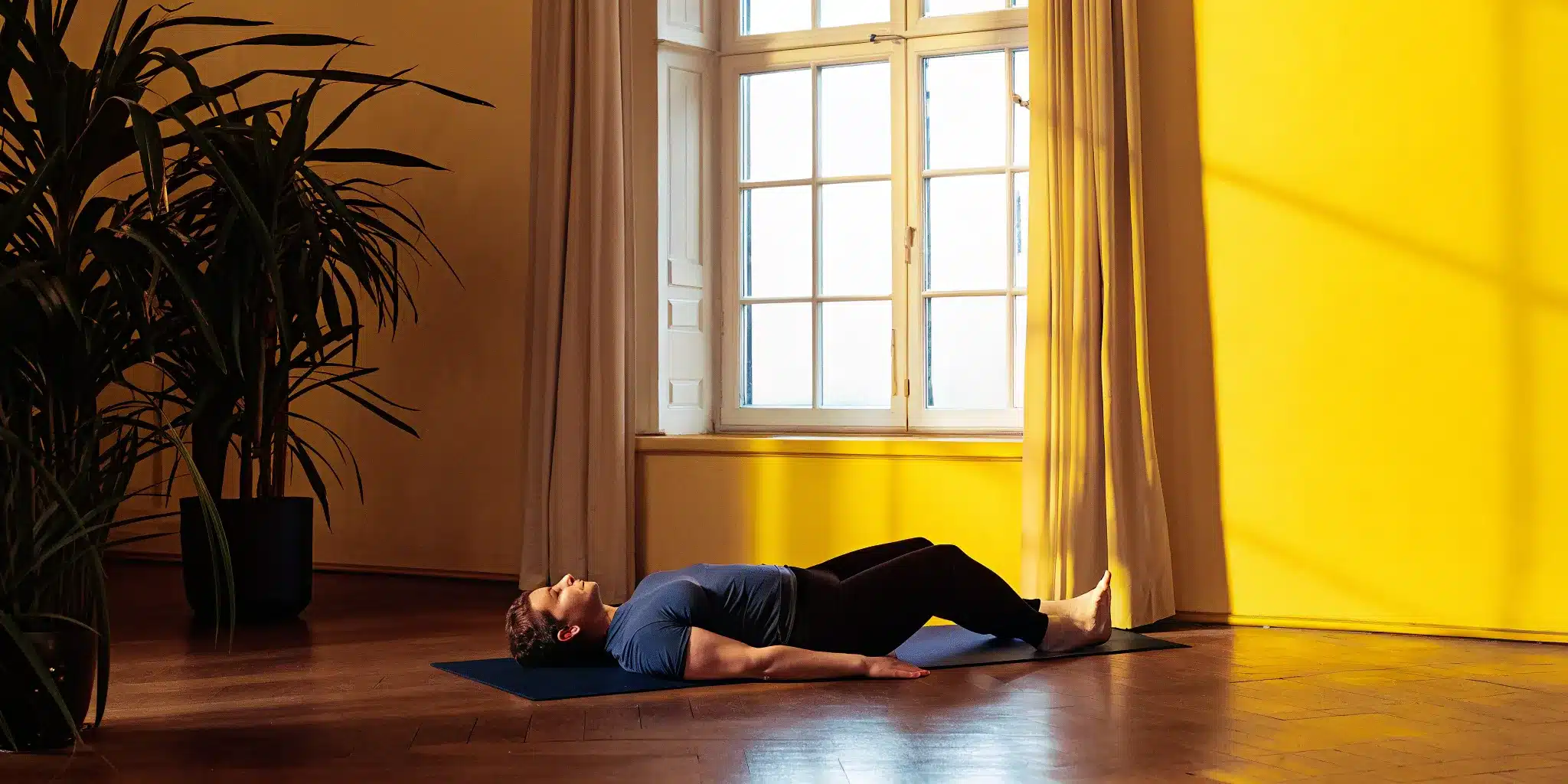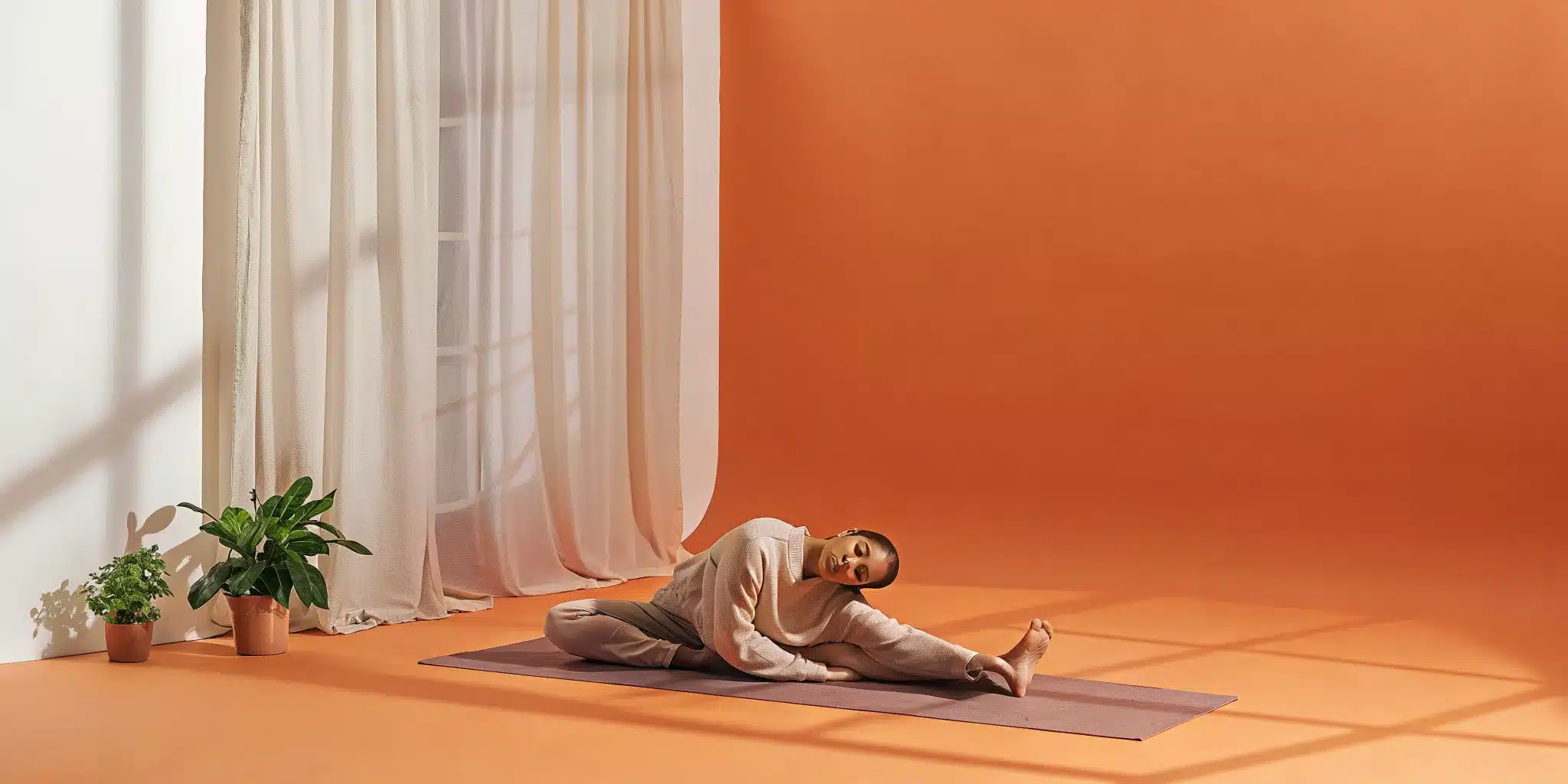Let’s clear up one of the biggest myths in fitness: holding a stretch for 30 seconds before you exercise is not the best way to warm up. While static stretching has its place for improving flexibility, doing it on cold muscles can actually decrease your power and stability. The key to a great workout is a great warm-up, and that means focusing on dynamic, active movements. Think of it as a dress rehearsal for your main activity. This approach prepares your muscles and nervous system for the work ahead. In this guide, we’ll break down exactly what to do, what to avoid, and how long should you stretch before a workout to ensure you’re primed for success and moving without pain.
Key Takeaways
- Choose the Right Stretch for the Right Time: Use dynamic, active stretches like leg swings and arm circles to warm up your body before a workout. Reserve static, “hold-it-there” stretches for your cool-down to improve flexibility and aid recovery.
- Prepare for Performance, Not Relaxation: The purpose of a warm-up is to activate your muscles and nervous system for the work ahead. Dynamic stretching accomplishes this by increasing blood flow and mobility, while static stretching can signal your muscles to relax, potentially decreasing your power.
- Keep Your Warm-Up Short and Specific: A quality warm-up doesn’t need to be long—five to 10 minutes is plenty. For the best results, tailor your dynamic stretches to the workout you’re about to do, mimicking the movements to prepare the specific muscles you’ll be using.
Dynamic vs. Static Stretching: What’s the Difference?
If you grew up in gym class doing “reach and hold” stretches before a run, you might be surprised to learn that’s not the best way to warm up. The world of stretching is mainly divided into two camps: dynamic and static. Think of dynamic stretching as an active warm-up. It involves movements that take your joints and muscles through a full range of motion, essentially mimicking the exercise you’re about to perform. Picture arm circles, leg swings, or torso twists.
On the other hand, static stretching is what most of us traditionally think of as stretching. It involves holding a specific position for a period—usually around 30 seconds—to lengthen a muscle. While both types have their place in a well-rounded fitness routine, knowing when to use each one is key to getting the most out of your workout and keeping your body safe.
Why You Should Stretch Before a Workout
The main goal of a pre-workout stretch is to prepare your body for what’s coming. This is where dynamic stretching really shines. These active movements help warm up your muscles by increasing blood flow and raising your body temperature. Think of it as gently waking up your body and telling it, “Hey, we’re about to move!”
This preparation does more than just make you feel ready; it enhances your range of motion, allowing you to move more freely and efficiently during your workout. Better circulation and more mobile joints can improve your overall performance and reduce your risk of injury. It’s a simple step that sets the stage for a safer, more effective exercise session.
The Case for Dynamic Stretching
When you’re short on time, it can be tempting to skip the warm-up. But a solid dynamic stretching routine doesn’t have to take long. Just five to ten minutes of targeted movements can make a significant difference. The idea is to prime the specific muscles you’ll be using. If you’re going for a run, focus on leg swings and hip circles. If it’s an upper-body day at the gym, arm circles and shoulder rolls are your best friends.
This type of active stretching prepares your muscles and nervous system for the work ahead. It’s a way of rehearsing the movements of your workout in a controlled, gentle way, which helps improve coordination and power once you get going.
Let’s Bust Some Common Stretching Myths
One of the biggest myths in fitness is that you should perform deep, static stretches before exercising. For years, we were told this was the best way to prevent injuries. However, modern research tells a different story. Holding a stretch for an extended period can actually relax your muscles too much, which isn’t ideal right before you need them to be powerful and responsive.
Studies have found that static stretching before a workout can decrease reaction time and performance and may even increase your risk of injury. Save those long, relaxing holds for your cool-down, when your muscles are warm and ready to be lengthened to improve flexibility and aid recovery.
How to Stretch Correctly Before Exercise
Getting your body ready for a workout is about more than just a few half-hearted toe touches. The way you stretch before exercise can set the stage for better performance and help you feel great afterward. It’s all about warming up your muscles with the right kinds of movements, for the right amount of time. Think of it as a gentle wake-up call for your body, signaling that it’s time to get moving.
The key is to focus on dynamic stretching—active movements that take your joints and muscles through a full range of motion. This approach increases blood flow, raises your body temperature, and prepares your nervous system for the activity ahead. Unlike the static, hold-it-right-there stretches you might remember from gym class, dynamic movements are fluid and controlled. We’ll walk through how long your warm-up should be, which stretches to save for later, and how to listen to your body so you know exactly when you’re ready to go.
How Long Should Your Warm-Up Be?
There’s no magic number here, but a good rule of thumb is to aim for five to 10 minutes of dynamic stretching. The ideal length of your warm-up really depends on what you’re about to do. If you’re heading out for a light jog, a few minutes of leg swings and walking lunges might be all you need. But if you’re preparing for a heavy lifting session or an intense sport, you’ll want to spend closer to 10 minutes getting your body fully prepared. A well-rounded dynamic stretching routine should target the specific muscle groups you’ll be using, ensuring they’re warm and ready for action.
When to Skip Static Stretching (and Why)
You should save your static stretches—the kind where you hold a position for 20-30 seconds—for after your workout. While they’re fantastic for improving flexibility and cooling down, doing them before you exercise can actually work against you. Research shows that pre-workout static stretching can temporarily weaken your muscles and decrease reaction time and performance. Think of it this way: you’re about to ask your muscles to be powerful and responsive. A long, relaxing stretch tells them it’s time to chill out, which is the opposite of what you need. Stick to active, moving stretches to warm up.
Tailor Your Stretch Time to Your Workout
The most effective warm-up is one that mimics the movements of your planned activity. Dynamic stretching is perfect for this because it warms up your muscles, gets your blood flowing, and enhances your range of motion in a way that’s specific to your workout. If you’re going for a run, focus on dynamic stretches like high knees, butt kicks, and leg swings. If you’re about to play tennis or golf, add in some torso twists and arm circles. By tailoring your warm-up, you’re not just preparing your body—you’re rehearsing the very movements you’re about to perform, leading to a more efficient and effective workout.
How to Know You’re Properly Warmed Up
Instead of just watching the clock, pay attention to how your body feels. A proper warm-up should leave you feeling loose, limber, and mentally ready. You’ll know you’re good to go when you feel a slight increase in your heart rate and may have even broken a light sweat. Your muscles should feel warm and pliable, and your joints should move more freely. The goal is to use active movements that gently prepare your body for the main event. When you feel energized and your movements feel smooth and unrestricted, that’s your green light to start your workout.
Your Go-To Pre-Workout Dynamic Stretches
Ready to build a warm-up that actually works? Dynamic stretching is all about active, controlled movements that take your joints and muscles through a full range of motion. Think of it as a dress rehearsal for your workout. Instead of holding a stretch, you’re actively moving, which gets your blood flowing, raises your body temperature, and tells your nervous system it’s time to get to work. This preparation is key to improving performance and reducing your risk of injury.
The best part is that you don’t need a lot of time. A solid dynamic warm-up can be done in just a few minutes, making it an easy habit to stick with. The goal isn’t to exhaust yourself but to gently wake up your body and prepare it for the specific demands of your planned activity. Below, we’ll walk through some simple routines and tips to help you create a pre-workout ritual that leaves you feeling strong, mobile, and ready to tackle any challenge. Whether you’re heading out for a run, hitting the weights, or just looking to move better, these stretches will set you up for success.
A 5-Minute Full-Body Warm-Up Routine
You don’t need a half-hour to get your body ready for exercise. A great dynamic stretching routine can take as little as five to ten minutes. The key is to choose movements that target major muscle groups and get your whole body involved. This quick sequence is perfect for when you’re short on time but still want to get in a quality warm-up.
Perform each of these movements for about 30 seconds:
- Arm Circles: Stand with your feet shoulder-width apart and extend your arms out to the sides. Make small circles, gradually making them bigger. Reverse direction halfway through.
- Leg Swings: Hold onto a wall for support. Swing one leg forward and backward, then side to side. Switch legs.
- Torso Twists: Stand with your feet wide and your arms extended. Gently twist your upper body from side to side.
- Walking Lunges: Step forward into a lunge, then push off your back foot to step into the next lunge.
Prepare Your Body for Specific Sports
The most effective warm-up is one that’s tailored to your workout. Dynamic stretches are fantastic because they can mimic the activity you’re about to do, preparing the exact muscles and movement patterns you’ll be using. If you’re about to go for a run, focus on movements like high knees, butt kicks, and walking lunges to activate your legs and hips. For a weightlifting session, bodyweight squats and push-ups will prime your muscles for lifting heavy loads. If you’re playing a sport like tennis or golf, add some torso twists to prepare your core for rotational movements. Think about the main actions in your workout and choose a few dynamic stretches that mirror them.
Tips for Increasing Intensity
As your body starts to warm up, you can gradually increase the intensity of your stretches. Start with smaller, slower movements and progressively make them larger and a bit faster. For example, when doing leg swings, begin with a gentle swing and slowly increase the height and speed as your hamstrings and hip flexors loosen up. You can also add a bit of light cardio at the end of your dynamic routine, like a minute of jumping jacks or jogging in place, to get your heart rate up. The goal is to feel warm and energized, not fatigued. Always listen to your body and increase the intensity in a way that feels controlled and comfortable.
How to Maintain Proper Form
Form is everything, even during your warm-up. The purpose of dynamic stretching is to move your body through its full range of motion in a controlled way. Avoid any bouncing or jerky movements, as this can put unnecessary strain on your muscles and joints. Focus on smooth, deliberate actions. For example, during a walking lunge, keep your torso upright and your front knee aligned over your ankle. If you’re unsure about your form, it’s always better to slow down or reduce your range of motion. A quality warm-up with proper form is far more effective and safer than rushing through sloppy movements.
The Pros and Cons of Pre-Workout Stretching
If you grew up playing sports, you probably remember your coach telling you to hold a quad stretch or touch your toes before every practice. For years, this kind of static stretching was the gold standard for warming up. But as we’ve learned more about how the body works, the conversation around pre-workout stretching has changed. It’s not about if you should stretch, but how you should stretch.
The key is understanding the difference between two main types of stretching: dynamic and static. Dynamic stretching involves active movements that take your joints and muscles through a full range of motion—think arm circles or leg swings. Static stretching is the classic “stretch and hold” method. While both have their place, doing the wrong one at the wrong time can do more harm than good. Choosing the right pre-workout stretches can prepare your body for a great session, while the wrong ones could leave you feeling sluggish or even increase your risk of getting hurt. Let’s break down the benefits and potential downsides so you can build a warm-up that truly works for you.
How Stretching Can Improve Performance
When done correctly, a pre-workout stretch routine can set you up for success. The goal of a warm-up is to gently prepare your body for the work ahead, and dynamic stretching is the perfect tool for the job. These active movements get your heart rate up and increase blood flow to your muscles, delivering the oxygen they need to perform.
Think of it like waking your body up. Dynamic stretches mimic the movements you’re about to do in your workout, which helps improve your mobility and range of motion. This preparation allows your muscles to contract more forcefully and quickly. A well-executed dynamic warm-up can lead to better coordination and power, whether you’re lifting weights, going for a run, or playing a sport. It’s all about getting your body primed and ready to move efficiently.
Does Stretching Actually Prevent Injuries?
This is one of the biggest myths in fitness. For decades, we were told that holding static stretches before exercise was the best way to prevent injuries. However, modern research tells a different story. In fact, studies show that using static stretches right before a workout can actually decrease your performance and may even increase your risk of injury.
When you hold a stretch for a long time, you’re telling your muscles to relax and lengthen. While that’s great for cooling down, it’s the opposite of what you want before you exercise. Your muscles need to be responsive and ready to fire, not loose and relaxed. A proper warm-up that includes dynamic stretching is what truly helps reduce injury risk by warming up the muscle tissue and improving elasticity, making your body more resilient to the demands of your workout.
The Benefit of Waking Up Your Muscles
A good dynamic warm-up does more than just get your blood pumping; it also strengthens the connection between your brain and your muscles. These active movements essentially send a signal to your nervous system that it’s time to get to work. This process, known as neuromuscular activation, helps your muscles fire more effectively and work together in a coordinated way.
By taking your joints through their full range of motion, dynamic stretching helps to warm up the muscles and improve your immediate flexibility. This preparation is essential for performing exercises with proper form and getting the most out of every repetition. When your muscles are awake and ready, you’ll feel more powerful, stable, and connected to your body throughout your entire workout session.
Potential Risks to Watch Out For
The biggest risk associated with pre-workout stretching comes from doing the wrong kind. As we’ve covered, static stretching before exercise is the main culprit. Holding a stretch can temporarily decrease muscle strength and power. Research has found that static stretching before activity can reduce muscular performance, which is especially important to avoid if your workout involves explosive movements like sprinting or jumping.
Think of your muscles like rubber bands. A warm, active rubber band is springy and resilient. A cold, overstretched one is less responsive and more likely to snap. By performing static stretches on cold muscles, you might be making them less prepared for the stress of a workout. The takeaway is simple: save the long, relaxing holds for your cool-down, when your muscles are warm and ready to release tension.
Create Your Perfect Pre-Workout Routine
Building a pre-workout routine that actually works for you doesn’t have to be complicated. The best warm-up is one that’s tailored to your body and your specific workout plans. It’s about tuning in and giving your muscles the prep they need to perform their best and stay safe. Forget the one-size-fits-all approach. Instead, think of your warm-up as a personal check-in before you ask your body to do the hard work. By focusing on a few key principles, you can create a simple, effective sequence that gets you ready to move, whether you’re heading out for a run or hitting the weight room.
Figure Out What Your Body Needs
Before you even start moving, take a moment to listen to your body. Are your hips feeling tight from sitting all day? Are your shoulders a little stiff? Your warm-up is the perfect time to address these spots with gentle, controlled movements. The goal is to prepare your muscles for the activity ahead. For this, dynamic stretching is most effective because it warms up your muscles, gets your blood flowing, and improves your range of motion. Think about the main muscle groups you’ll be using in your workout and focus your attention there. This mindful approach ensures you’re not just going through the motions but actively preparing for a better, safer workout.
Design a Quick and Effective Sequence
You don’t need to spend 30 minutes warming up. In fact, a great dynamic stretching routine can take as little as five to ten minutes. The key is to be efficient and intentional with your movements. Start with larger, general movements to get your heart rate up slightly, like jogging in place or doing jumping jacks. Then, move into more specific dynamic stretches that target the muscles you’ll be using. For example, if you’re planning to run, focus on leg swings and walking lunges. If it’s an upper-body day, arm circles and torso twists are great options. A well-designed sequence should feel fluid and leave you feeling energized, not exhausted.
Adapt Your Routine for Different Workouts
Your warm-up for a long run should look different from your warm-up for a heavy lifting session. Tailoring your routine is crucial for getting the best results. For cardio-heavy activities like running or cycling, focus on dynamic stretches that mimic the motion, like high knees and butt kicks. For strength training, you’ll want to activate the specific muscles you’re about to train. Bodyweight squats before a squat session or push-up planks before bench pressing can make a huge difference. Remember, dynamic stretches are for preparation, while static, hold-in-place stretches are best saved for your cool-down to help with recovery.
How to Tell if Your Routine Is Working
So, how do you know if your warm-up is doing its job? You should feel physically ready to go. A good sign is a light sweat, an elevated heart rate, and a feeling of looseness in your muscles and joints. You shouldn’t feel fatigued, but rather primed and focused. During your workout, you should feel that your movements are smooth and your range of motion is comfortable. Research shows that the right kind of warm-up pays off; one study found that dynamic stretching can increase muscular performance, while static stretching beforehand can actually hinder it. If you feel sluggish or stiff during your workout, it might be time to revisit and adjust your pre-workout routine.
Avoid These Common Stretching Mistakes
Stretching seems simple enough, but a few common missteps can keep you from getting the full benefits. The goal is to prepare your body for movement and feel better, not to cause pain or hinder your performance. If your stretching routine isn’t making you feel more mobile and ready for action, you might be making one of these easy-to-fix errors.
Let’s get one thing straight: not all stretching is created equal, and timing is everything. Doing the right stretch at the wrong time can be counterproductive. The good news is that correcting your course is simple. By understanding when, how, and what to stretch, you can make sure every movement serves its purpose—warming up your muscles, improving your range of motion, and helping you move with more freedom and less pain. Let’s walk through the most frequent mistakes and how to correct them so you can stretch with confidence.
Getting the Timing and Duration Wrong
One of the biggest mistakes is stretching for too long—or too short—before a workout. A pre-workout warm-up isn’t the time for a long, deep stretching session. Your goal is simply to wake up your muscles and get your blood flowing. A dynamic stretching routine should last about five to 10 minutes. This is just enough time to target the major muscle groups you’ll be using without fatiguing them before you even start your main activity. Think of it as a gentle signal to your body that it’s time to move, not a full-on flexibility workout. Save the longer, more intense stretching for your cool-down.
Choosing the Wrong Types of Stretches
This is a big one. Many of us were taught to hold static stretches (like a hamstring stretch) before exercise, but that’s outdated advice. Pre-workout, you should focus exclusively on dynamic stretches—active movements that take your joints and muscles through their full range of motion. Think leg swings, arm circles, and torso twists. These movements increase blood flow and body temperature, which helps improve performance and reduce injury risk. Static stretching, which involves holding a position for 20-30 seconds, is best saved for after your workout. Holding a stretch before activity can actually tell your muscles to relax too much, potentially decreasing power and stability when you need it most.
Simple Ways to Correct Your Form
Even with the right type of stretch, poor form can hold you back. With dynamic stretching, the key is control. Avoid bouncing or using jerky motions to force a deeper stretch. This can put unnecessary strain on your muscles and tendons. Instead, focus on smooth, deliberate movements. For example, during a leg swing, move your leg through its natural range of motion without forcing it higher than it wants to go. Pay attention to your posture—keep your core engaged and your back straight. Listening to your body is crucial. A stretch should feel like a gentle release, never a sharp or shooting pain.
Are You Overdoing It? Signs of Over-Stretching
More isn’t always better, especially when it comes to warming up. Pushing your stretches too far or holding them for too long before a workout can do more harm than good. One of the biggest signs you’re overdoing it is feeling weaker or less powerful during your actual workout. Research shows that prolonged static stretching before activity can reduce muscular and sprint performance. Another red flag is pain. If you feel a sharp, stabbing sensation, you’ve pushed too far. A proper warm-up should leave you feeling energized and limber, not sore or strained. If you feel tired or notice your performance is dipping, it might be time to scale back your pre-workout stretching.
Frequently Asked Questions
What’s the simplest way to remember the difference between dynamic and static stretching? Think of it this way: dynamic stretching is active and involves movement. You’re preparing your body for an activity, so you move through stretches like leg swings or arm circles. Static stretching is still and involves holding a position. This is best for after your workout when your muscles are warm and you want to improve your flexibility and cool down.
Is it really that bad to do my old “reach and hold” stretches before I run? It’s not the most effective way to prepare your body, and it could work against you. Holding a stretch for a long time tells your muscles to relax and lengthen. Right before you need them to be powerful and responsive for a run, this can temporarily decrease your performance and stability. It’s much better to warm up with active movements that mimic running.
How do I know if I’m warmed up enough to start my workout? Instead of just watching the clock, tune into how your body feels. A good warm-up should leave you feeling loose, focused, and energized. You’ll know you’re ready when your heart rate is slightly up, you may have broken a light sweat, and your joints and muscles feel more fluid and ready to move.
I have some chronic aches and pains. Should I still do dynamic stretches before exercise? Yes, a gentle warm-up is especially important when you’re managing pain. Dynamic stretching can help by increasing blood flow to your muscles and improving mobility around your joints. The key is to listen to your body. Start with slow, controlled movements and never push into a range of motion that causes sharp pain. A proper warm-up should make you feel better, not worse.
What if I’m really short on time? Is it better to skip the warm-up or just do a couple of minutes? A couple of minutes is definitely better than nothing! Even a very short warm-up can make a big difference in how you feel and perform. If you only have three minutes, pick three dynamic movements that target the muscles you’re about to use. A quick round of leg swings, torso twists, and arm circles is far better than jumping into a workout with cold muscles.








